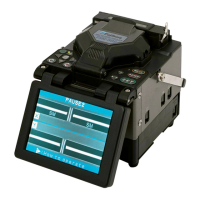
Do you have a question about the Fujikura FSM–50S and is the answer not in the manual?
| Type | Fusion Splicer |
|---|---|
| Splicing Method | Core Alignment |
| Fiber Count | Single |
| Typical Splice Loss (SM) | 0.02 dB |
| Typical Splice Loss (MM) | 0.01dB |
| Typical Splice Loss (DS) | 0.04dB |
| Return Loss | ≥60dB |
| Operating Environment Altitude | Up to 5000 m |
| Operating Temperature | -10 to +50 °C |
| Battery Operation | Yes |
| Applicable Fibers | DS, NZDS |
| Cladding Diameter | 80 - 150 μm |
| Coating Diameter | 100 - 1000 μm |
| Applicable Sleeves | 60 mm |
| Heating Time | Typical 30 seconds with FP-03 sleeves |
| Splice Memory | 1000 |
| Operating Environment Wind | Max 15 m/s |
| Operating Humidity | 0 to 95%RH (non-condensing) |
| Storage Humidity | 0 to 95%RH (non-condensing) |
| Battery Life | Approx. 200 splices |
Explains different splice modes like SM, AUTO, and their applications.
Details the automatic arc calibration feature and its operation modes.
Lists and illustrates the main parts and accessories of the fusion splicer.
Details essential tools and consumables required for fiber splicing.
Explains how to connect AC adapter or battery for power supply.
Guides on powering on the splicer and initial screen display.
Explains the process of stripping and cleaning the optical fiber coating.
Provides step-by-step instructions for cleaving optical fibers.
Outlines the standard procedure for performing a fusion splice.
Details the process of heating the protection sleeve to complete the splice.
Critical cleaning points and checks for maintaining splice quality.
Recommends regular inspection and cleaning for sustained quality.
Details how to select and configure splice modes for different fiber types.
Explains selecting and editing heater modes for protection sleeves.
Describes the process of calibrating arc power for optimal splicing.
Covers common parameters for splicing and tube heating settings.
Details how to display and manage stored splicing results.
Instructions to change the monitor position and clamp direction.
Configuration of power saving features for energy conservation.
Manages function access, startup settings, and other system options.
Procedure for replacing worn-out electrodes to maintain performance.
Performs a series of tests to evaluate splicer performance.
Checks the optical path for dust and its impact on splicing.
Calibrates the speed of the splicer's six motors.
Displays serial number, ROM version, and maintenance history.
Addresses common issues related to power supply and battery operation.
Troubleshoots problems encountered during the splicing process.
Provides solutions for issues during the tube heating process.
Addresses various operational queries and advanced functions.
Details the warranty period, limits, and conditions for repairs.
Lists contact information for Fujikura service centers worldwide.